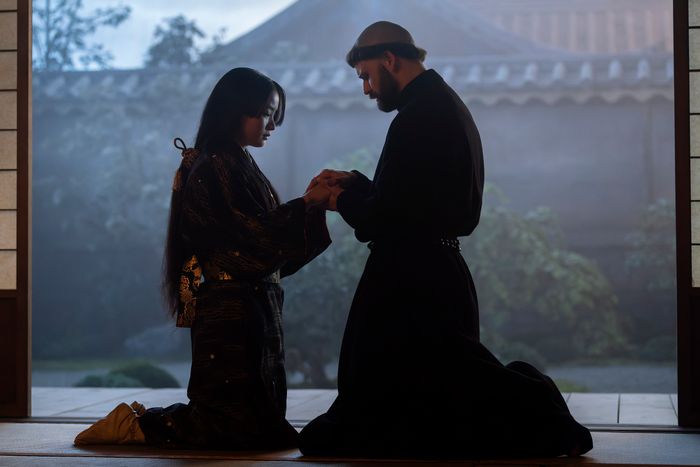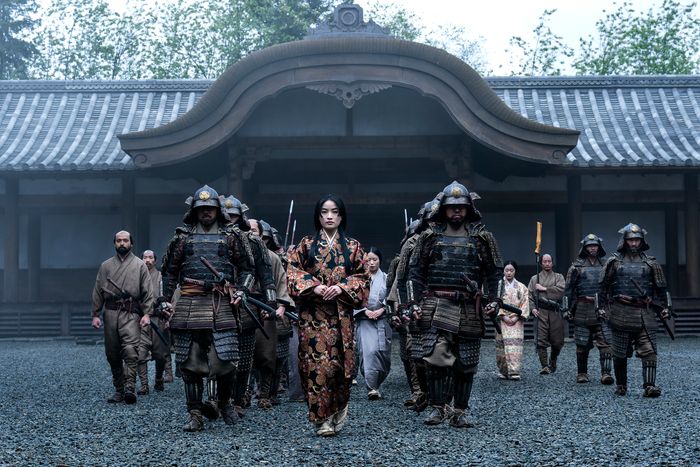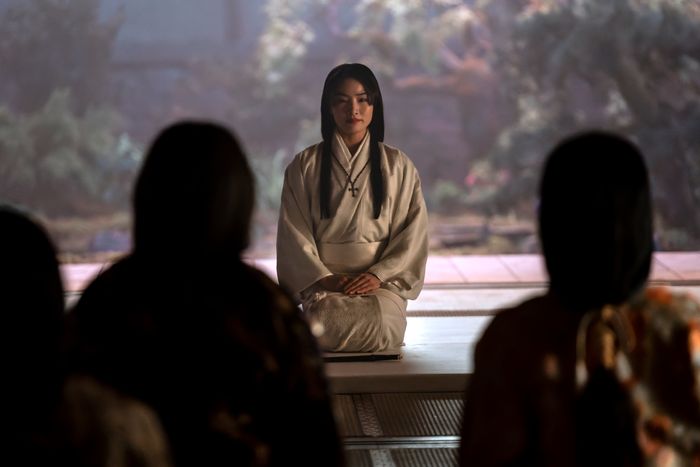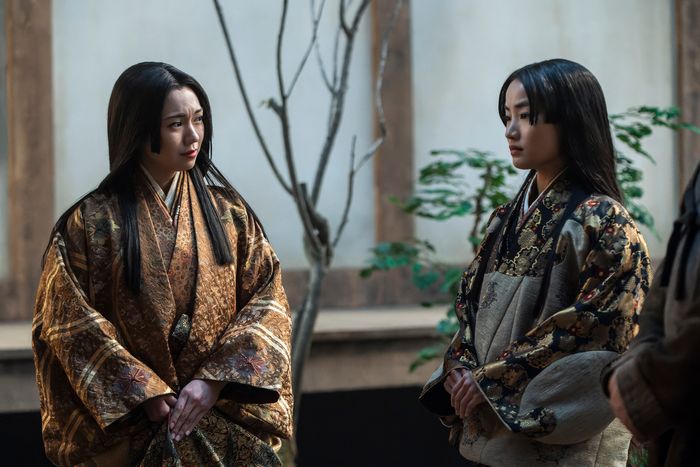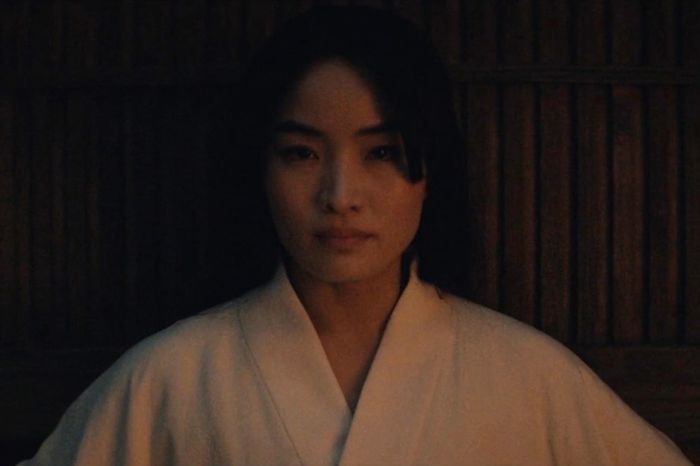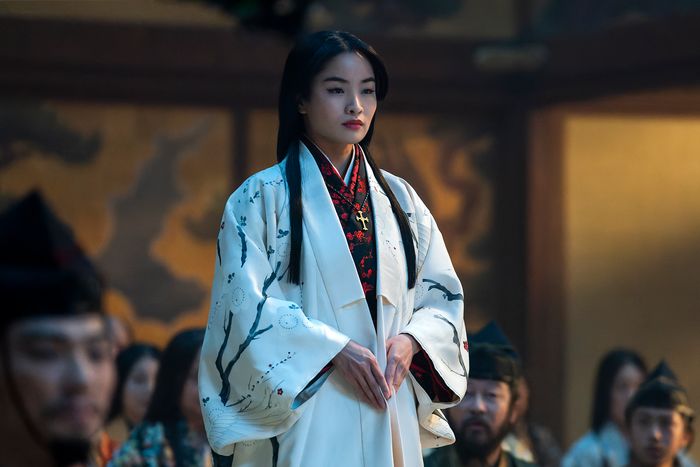
Toda Mariko, a noblewoman burdened with family shame, spends much of FX’s Shōgun yearning for death. In “Crimson Sky,” the penultimate episode of the show set during the climax of Japan’s Sengoku Jidai — the Era of the Country at War — Mariko is finally granted her wish. When Lord Ishido sends men to capture her alive, Mariko stands in front of the explosion that ends her life and possibly Ishido’s reputation.
Mariko’s historical counterpart, Hosokawa Gracia, also met a dramatic end. Twenty-four years before she was christened Gracia and 16 years before she married Hosokawa Tadaoki (the inspiration for Shōgun’s Buntaro), Akechi Tama was born in 1563 to the warlord Akechi Mitsuhide, whose betrayal of his liege lord Oda Nobunaga in 1582 forever tainted her as a traitor’s daughter. And in 1600, she died a similarly violent death when Ishida Mitsunari (Ishido in Shōgun) attempted to take her hostage in a bid for leverage in his war against Tokugawa Ieyasu (Toranaga). But while the arc of Mariko’s life and death reflects that of Gracia, it is not an exact mirror. Here’s how “Crimson Sky” abridges and combines elements of the historical record in the name of dramatic license.
The Conversion
“Crimson Sky” begins with a flashback to Mariko despairing in wake of her father’s death and family’s disgrace before Portuguese priest Martin Alvito promises her spiritual solace through Jesus Christ. This moment of conversion would have happened differently for Tama, who did not have regular access to priests; even after her pardon by the future Taikō, Toyotomi Hideyoshi, she was kept confined in an Osaka mansion. Tama secretly visited a Jesuit church on Easter Sunday and began exchanging messages with the priests through her maid Kiyohara Ito (christened Maria), discussing theological points and requesting books. In 1587, unable to leave the mansion or invite a priest inside, Tama had Maria baptize her, and she emerged with a new Portuguese name, Gracia.
Unfortunately for her, this coincided with the beginning of Hideyoshi’s crackdown on Christian missionary activity and other Jesuit practices, causing tension between the newly baptized Gracia and her husband, who frequently abused her and her Christian maids. Yet Gracia, encouraged by the priests to suffer in imitation of Christ and for the promise of eternal afterlife, resolved to stay in disharmonious matrimony with Tadaoki. According to the Hosokawa family record, though, Gracia defied Tadaoki on multiple occasions, once wearing a bloody kimono for several days to protest his killing of a servant. “When the husband is an ogre, it is fitting that his wife be as obstinate as a snake,” she told him with the cool resolve of a samurai woman. Some Jesuit accounts claim that Tadaoki’s hostility diminished over time, especially after the temporary relaxation of anti-Christian policies following Hideyoshi’s death in 1598.
While Mariko has relative freedom of movement in Shōgun’s present day, Gracia remained in Osaka for the rest of her life, never acting as an official translator (though she did learn Latin and Portuguese) or meeting a gruff English ship pilot. Both, however, shared a willingness to die. Whether Gracia asked her husband to kill her is unrecorded, but her letters to Portuguese priests were full of declarations that she would martyr herself if Hideyoshi enforced his anti-Christian edicts, which he sometimes did.
The Breakout Attempt
The violence and disorder of the Sengoku period meant that women often had to defend their castles and villages in the men’s absence, and occasionally by their side. “Crimson Sky” inverts this with Mariko’s doomed attempt to escape Osaka Castle with Lord Toranaga’s family, wielding a curved blade mounted on a long shaft against Ishido’s guards. (The naginata, with its long-reaching strikes, became a preferred weapon for women in the samurai class, who did not need to apply excessive force or move beyond the confines of their kimono to wield it effectively.) Although no known accounts depict Gracia attempting to escape her confinement by force, many stories recorded in the Hosokawa family history emphasize Gracia’s “manly” (danshi no ke aru) courage. According to one story, she avoided Hideyoshi’s sexual advances by threatening, through Tadaoki, to kill him with a dagger and avenge her father’s defeat at his hands. Another suggested that in times of utmost need, she was prepared to don her armor and mount a horse to confront her and her family’s enemies.
High-ranking women of the samurai class like Gracia and Mariko would have typically undertaken at least some training with weapons, which also served to harden their endurance and discipline in preparation for their roles as wives and mothers. Managing a samurai household, in turn, prepared them to organize the garrison and inhabitants of a castle under siege. By contrast, women’s involvement on an open battlefield was seldom recorded. One exception, which Mariko would likely be familiar with, was Tomoe Gozen, a much-mythologized warrior-woman (onna-musha) from the 12th-century Genpei War who fought across Japan wielding a sword (katana) in addition to a naginata. In doing so, Gozen pushed the limits of contemporary femininity, and her exploits, recorded in the national epic Heike Monogatari, provided rich seams of literary and dramatic material that later characterized her in more conventionally gendered terms. Some of those later versions identify Gozen as her lord’s lover or have her become a nun to pray for the souls of her male dead, among other changes; the shifts in narrative mirrored the erosion of women’s legal rights in an increasingly militarized society.
The Ritual
In the end, Mariko is just one woman in the face of many foes, and she is unable to fulfill her duty to Toranaga. The failure leads her to attempt ritual suicide, with assistance from a second to deliver the coup de grâce so that she does not die a sinner. Though Shōgun depicts her preparing for seppuku — cutting open the stomach usually followed by beheading — that form of suicide was exclusively practiced by men. A woman of the samurai class would typically cut her neck arteries instead.
While seppuku has been a part of Shōgun from its very first episode, the samurai acceptance of oblivion does not equate to a reckless yearning for death. Ritual suicide was usually limited to situations where they faced the shame of capture and torture, strongly remonstrated with their lord, or, in the case of close retainers and family members, followed their defeated lord in death. Nonetheless, the willingness to die under those circumstances was strong, and cutting open the stomach, considered the seat of one’s emotions, demonstrated the purity of a samurai’s honor.
The Death Poem
Before the ritual, Mariko gives one of Toranaga’s consorts her death poem (jisei), traditionally written in tanka form by literate Japanese as death approaches and thematically distinct from other kinds of Japanese poetry. Reflecting on the nature of life and death, jisei draw from the Buddhist principle that in a transient material world, attachment leads to the nonexistence of self; the Japanese love for nature means the inevitable expression of ephemerality through metaphors like falling dew, withering flowers, and changing seasons — explicit use of the d-word is atypical.
While we aren’t privy to the contents of Mariko’s death poem, her earlier conversation with Ochiba, which Mariko concludes with the declaration that “flowers are only flowers because they fall,” nods to the contents of Gracia’s jisei, which reads:
Because they know when
Their time to perish has come
In this world of ours
Blossoms fall as blossoms will
And people as people will.
The Final Sacrifice
In death, Mariko and Gracia’s stories rejoin. Mariko’s suicide is averted when Ishido barges in with a permit — she can leave along with Toranaga’s family. Unfortunately, Ishido is a liar. Hoping to keep a hostage while avoiding the disgrace of hounding a prominent noblewoman to death, he sends a group of shinobi to bundle Mariko off to his section of Osaka Castle.
Similarly, Ishida Mitsunari, preparing for war against Tokugawa Ieyasu and seeking leverage over Gracia’s husband, ordered soldiers to take Gracia from the Hosokawa residence to Osaka Castle. Chaos ensued, and while details of what happened are debated, two things are certain: The house burned down, and Gracia, like Mariko, died violently.
Most accounts record that after Gracia sent her maids away and escape became improbable, a clan retainer informed Gracia that he had orders from Tadaoki to kill her should her honor be threatened. Gracia, who had long prepared for this moment as a Christian with clear conscience, responded that she would accept death without fear. The retainer then struck her down with a halberd, set the mansion ablaze, and committed seppuku. Some later Japanese sources say that she killed herself in the traditional manner.
Whether Gracia accepted death out of defiance toward her clan’s enemies, fidelity to her husband and his lord, sympathy for a retainer bound by his liege’s order, or something else cannot be known. As a historical figure, Gracia has become a vessel for convenient narratives — to many Europeans, a narrative of martyrdom, Christian virtue, and spousal duty; to many Japanese, a narrative of loyalty, samurai honor, and also spousal duty. Like Toda Mariko, Hosokawa Gracia’s third heart, her secret heart, will never be known to anyone except herself.


